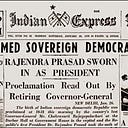The National Identity XXVIII: The Minority Army
The Indian Army’s gradual re-composition
Think of the infantry regiments of the present day Indian Army. Almost down to the last regiment, the history of each spreads well over 175 years and in some cases 275 years. The roll call of names — Sikh, Rajputana Rifles, Punjab, Jat, Dogra, Kumaon, Gharwal, Gurkha and on and on. This is a rich history that the modern Indian Army cherishes. There isn’t a theatre of war in the 20th century that the Indian Army hasn’t seen action in. As part of the British Empire — the Indian Army were the guarantors of peace in the region stretching from East Africa and the Middle East to Singapore — including modern day Eritrea, Iran, Iraq, Israel, Palestine, Afghanistan, Pakistan, India, Nepal, Bangladesh, Bhutan, Myanmar, Thailand and Singapore. They were even deployed in China in 1860 and 1900. India wasn’t an ordinary British colony — it had its own office in London, as part of the British bureaucracy, the India Office. The top rankers of the Civil Services exam would be allocated to the India Office. John Maynard Keynes stood second in the exam and entered the India Office in October 1906. Much as India was the jewel in the crown of the British Empire, the Indian Army was the real power behind the might of the British Army.

